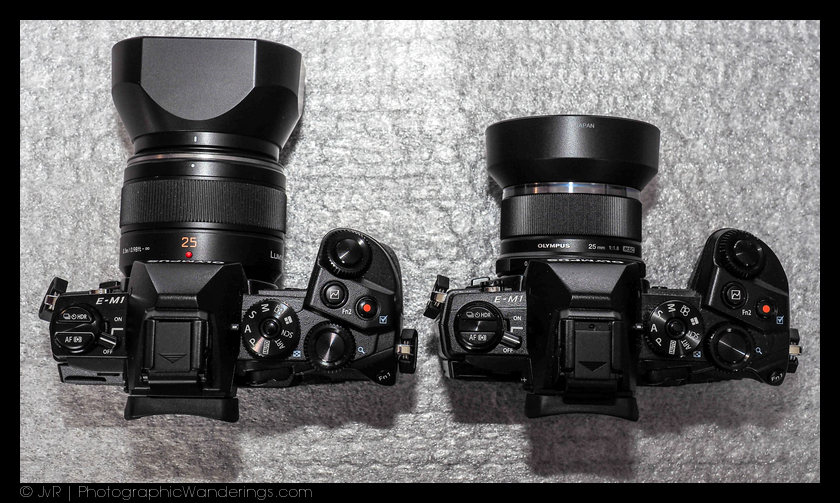A few weeks ago, Olympus launched a 25mm f/1.8 lens for the Micro Four-Thirds format, finally kind of catching up with the existing Panasonic Leica 25mm f/1.4 lens. Kind of, because the Olympus doesn't have that magical f/1.4 aperture that seems to be the distinguishing feature between low-end f/1.8 50s and higher-end f/1.4 50s in the DSLR world (25mm is the MFT equivalent for 50mm in full-frame format). With the new Sony Sonnar T* FE 55mm f/1.8 coming out at the same time, though, and that lens being lauded as one of the best normal lenses ever, f/1.8 might just have a chance to be taken seriously. Even better for Olympus, its lens comes in at $400, compared with the Panasonic at $529 and the Sony at $1,000.
I have had the Panasonic for a long time, first for my Olympus OM-D E-M5 and now for the E-M1. I rented the Olympus 25mm to see how it compares with the Panasonic. Both lenses were tested on the E-M1.
You won't find many images in this comparison. I have an aversion against posting simple comparison pictures, especially if others have already posted those. I generally only post pictures taken in the real world, but the real world is pretty messy after multiple snow storms. So, I lack images taken with the Olympus lens that are worthwhile to post.
This means, of course, that I expect you to take my word for what I say. Thus, a few disclaimers are in order.
I'm not a lens tester. I don't have special gear, wall cards or expertise for testing lenses. I just take pictures of the same stuff under exactly the same circumstances and compare them on my computer monitor, just like most of you would do. But this does mean that my methods could well have enormous holes in them. For one, I have just one copy of each lens. The Panasonic is about a year old. The Olympus is a rental. I haven't run either lens through a battery of tests. Still, what I did find is largely in line with what others seem to find.
Also, let me admit that I'm biased against the Panasonic. Always have been. I think the lens is too large for MFT. It's a large chunk of plastic and glass compared with the Olympus MFT lenses. I only bought it because I like to have a 50mm-equivalent lens for a system camera and this was the best autofocus choice at the time.
That's the bias I started out with and seeing the two side-by-side only confirms my bias.
Winner
To cut to the chase, after shooting with both lenses, I'm pretty sure the Olympus is the winner.
Here's why:
it's smaller, a bit lighter and cheaper;
it suffers less from chromatic aberration, at least when used with the Olympus E-M1;
it's a bit faster to focus.
And:
sharpness is close, sometimes the Olympus wins (edges), sometimes the Panasonic (center), depending on apertures used;
the depth-of-field difference between f/1.4 and f/1.8 is negligible;
bokeh is virtually identical.
Now, only the size and the chromatic aberration are things you will notice and if you can live with the size, the other one can be corrected on the computer. Plus, the CA might not be a problem if you use Panasonic cameras. Looking through the real-world photographs I took with the Panasonic, I didn't encounter the CA before. It only showed up when I did these tests, but it was pronounced.
I'm thinking about selling the Panasonic and buying the Olympus. I like smaller lenses for a smaller system, at least if the size difference doesn't hurt the image quality. That's me, though, and you'll do fine with the Panasonic if you already own it. If you really want that larger f/1.4 aperture for low-light work, get the Panasonic. Otherwise, if you buy new, get the Olympus and save some money.
By John van Rosendaal

